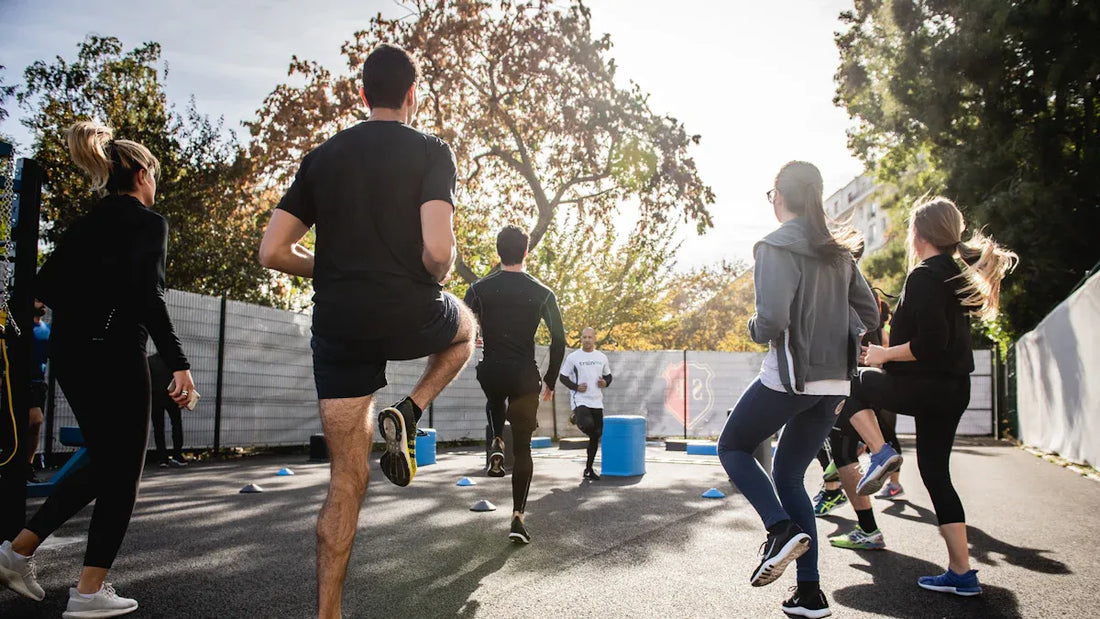
The advantages and benefits of outdoor sports and how to buy outdoor sports hydration packs and tactical packs
Share
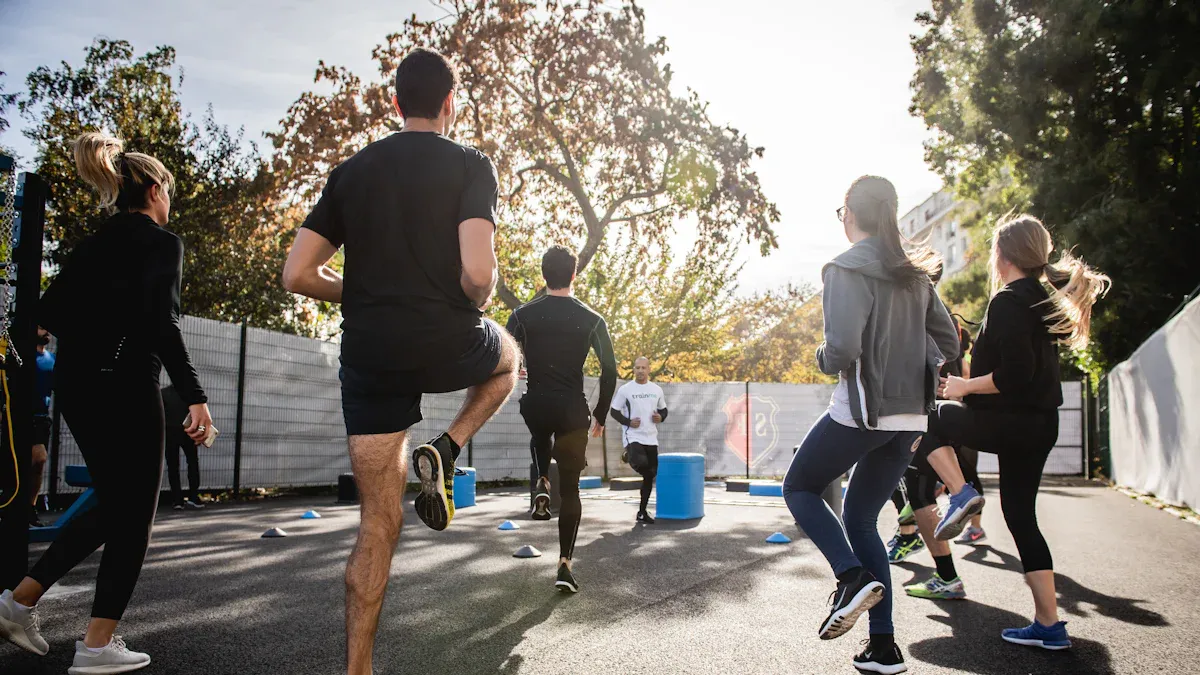
You might notice more people heading outside for adventure these days. In 2023, outdoor recreation saw a 4.1% jump, with 175.8 million people joining in. Outdoor sports offer real benefits for your body and mind. Staying hydrated and having the right gear helps you avoid muscle fatigue, keeps your joints healthy, and sharpens your focus. The right hydration and tactical packs can make your next adventure safer and more enjoyable.
Key Takeaways
Outdoor sports improve physical health by increasing fitness, enhancing cardiovascular function, and reducing obesity. Regular activity outdoors leads to a stronger, healthier body.
Mental well-being benefits from outdoor sports include reduced stress and improved mood. Nature helps you feel more relaxed and focused, making outdoor exercise a great choice for mental health.
Staying hydrated is crucial during outdoor activities. Drink half your body weight in ounces daily, plus extra for each hour of activity, to maintain energy and prevent dehydration.
Choose the right hydration pack based on your activity. Lightweight vests are great for running, while larger backpacks suit longer hikes. Comfort and fit are key for an enjoyable experience.
Invest in quality tactical packs that fit your needs. Look for durable materials, good warranties, and read reviews to ensure you select a pack that will last through many adventures.
Outdoor Sports Benefits
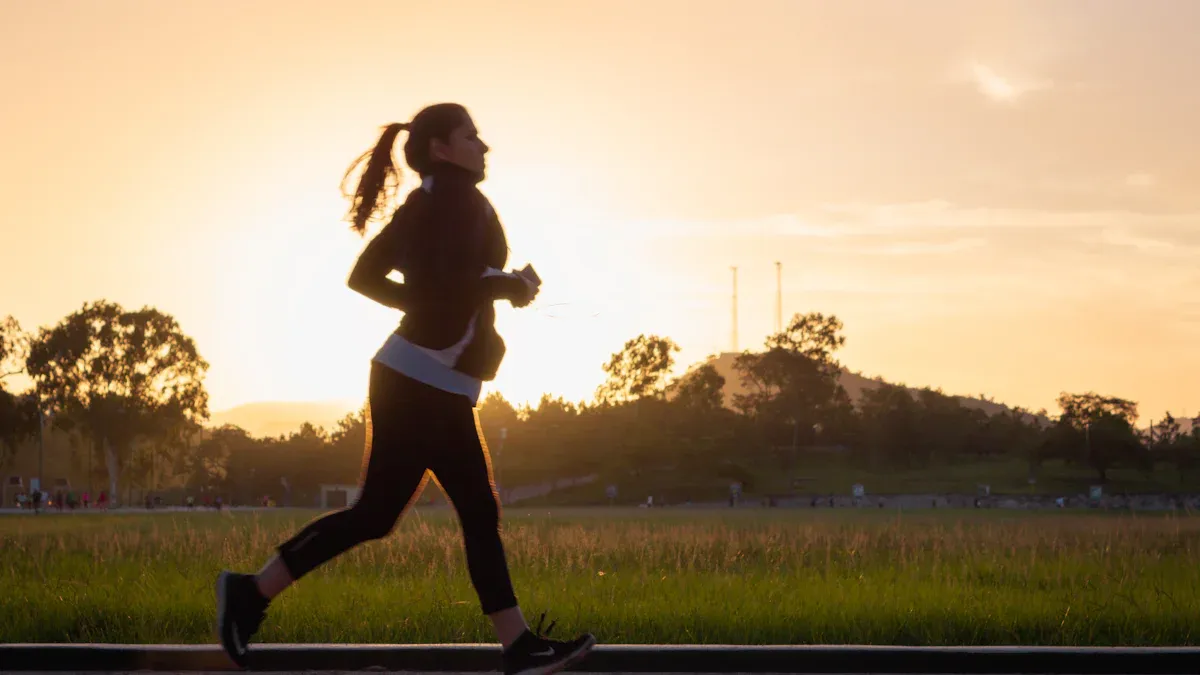
Physical Health
When you join outdoor sports, your body gets stronger and healthier. You move more, which helps your heart and muscles. Take a look at some of the proven health benefits:
Health Benefit |
Description |
|---|---|
Increased fitness |
You build strength and stamina by staying active outdoors. |
Better cardiovascular function |
Your heart and blood flow improve with regular activity. |
Reduced blood pressure |
Outdoor sports can help lower your blood pressure. |
Decreased obesity |
Staying active outside helps you manage your weight. |
Improved resting heart rate |
Your heart works more efficiently, even when you rest. |
Enhanced subjective health perception |
You feel healthier and more energetic. |
Better physical quality of life |
You enjoy a higher quality of life with regular outdoor activity. |
Maintenance of physical performance |
Older adults can keep their bodies strong and capable. |
Vitamin D levels |
Sunlight boosts your vitamin D, which is good for your bones. |
Disease prevention |
Outdoor sports may help prevent some diseases, like multiple sclerosis and myopia. |
You also spend less time sitting and more time moving. This can lower your risk for chronic diseases. Outdoor activities may even give you extra health benefits compared to indoor exercise.
Mental Well-being
Outdoor sports do more than help your body. They also lift your mood and calm your mind. Studies show that being outside while you exercise can reduce stress and make you feel happier.
Study Title |
Findings |
|---|---|
Optimizing mental health benefits of exercise: The influence of the exercise environment on acute stress levels and wellbeing |
Outdoor exercise feels more calming and reduces stress better than indoor exercise. |
Nature-based outdoor activities for mental and physical health: Systematic review and meta-analysis |
Activities like hiking or gardening in nature improve mental health, especially for adults who already feel stressed. |
You might notice you feel more relaxed and focused after a walk or game outside. Nature has a way of helping you reset.
Social Connections
You can make new friends and build stronger relationships through outdoor sports. When you play or explore outside, you meet others who share your interests.
Outdoor sports in parks or natural spaces help kids and teens make friends.
Neighborhood activities, like group hikes or games, bring people together.
Playing outside gives you more chances to talk, laugh, and learn social skills.
Tip: Invite a friend or family member to join you next time. You might discover a new favorite activity together!
Hydration in Outdoor Sports
Importance of Hydration
When you play or train outside, your body loses water fast, mostly through sweat. You need to replace that water to keep your body working well. Staying hydrated helps your muscles move, keeps your joints healthy, and lets you think clearly. If you want to know how much water you need, here are some simple tips:
Drink half your body weight in ounces of water every day.
For each hour you spend being active, add 15 to 20 more ounces.
Men should aim for about 125-130 ounces (16 cups) of fluid daily.
Women should try for 91-95 ounces (12 cups) each day.
You might not always feel thirsty, but your body still needs water. Good hydration helps you avoid injuries and keeps your energy up during outdoor sports.
Risks of Dehydration
Dehydration can sneak up on you, especially when you’re busy having fun. Watch out for these early warning signs:
Less urine than usual
Dizziness or feeling lightheaded
Dry mouth and eyes
Feeling tired
Headache
Feeling very thirsty
If you ignore these signs, things can get worse. Severe dehydration may cause confusion, a fast heartbeat, or even trouble breathing. You could also face serious health problems like heatstroke, kidney issues, or seizures. Here’s a quick look at how often dehydration affects athletes:
Group |
% Reporting Performance Decrease |
% Reporting Heat-Related Illness Symptoms |
|---|---|---|
High |
54% |
|
Overall |
70% |
45% |
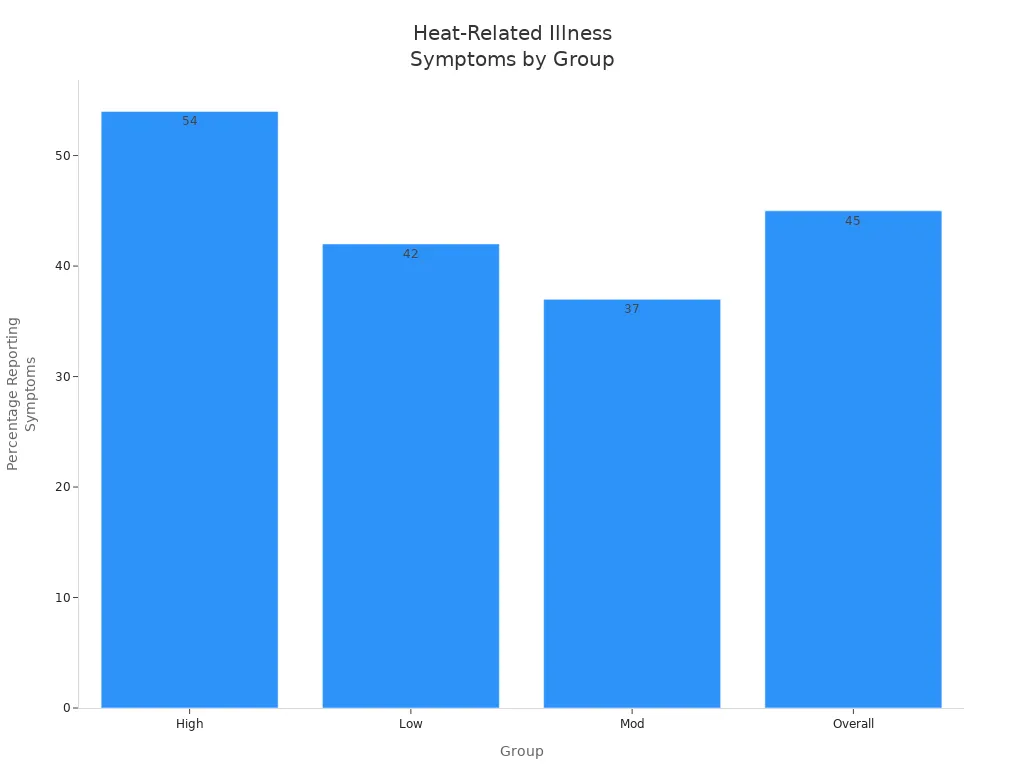
Tip: If you notice any of these symptoms, take a break and drink water right away.
Performance Impact
Hydration makes a big difference in how well you play. When you don’t drink enough, your body can’t cool itself, and your muscles get tired faster. Studies show that losing just 2% of your body water can hurt your endurance and strength. Dehydration can:
Lower your aerobic capacity and muscle endurance
Increase your blood lactate, making you feel more tired
Reduce your sprinting and running ability
Cut your strength by about 2% and your power by about 3%
Drop your high-intensity endurance by up to 10%
You might notice you can’t run as fast, jump as high, or play as long. Even activities that last more than 30 seconds can feel much harder. Staying hydrated helps you play your best and enjoy every moment outside.
Hydration Packs
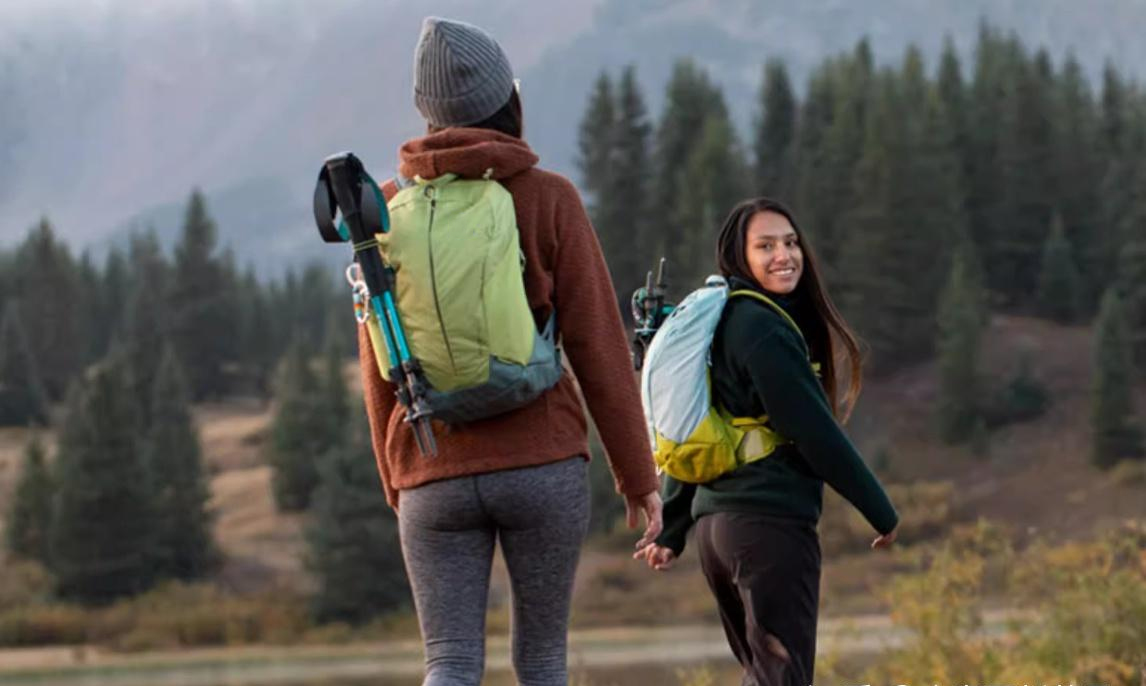
Types
You have lots of choices when it comes to hydration packs. Each type fits a different outdoor activity. If you like running, you might want a lightweight running vest. These vests hug your body and keep water from bouncing around. For longer hikes, a hydration backpack gives you more space for gear and a bigger water reservoir. Waistpacks work well for short runs or walks. They carry just enough water and a snack. Some packs are made for skiing or cold weather. These have insulation to keep your water from freezing.
Type of Hydration Pack |
Description |
|---|---|
Hydration Packs for Running |
Small and light, with a reservoir of 1.5-2 liters. |
Daypacks with Hydration Reservoir |
Bigger packs for day hikes, with 2-3 liters and extra gear space. |
Packs for Hiking and Backpacking |
Large packs for long trips, with 3 liters or more and lots of storage. |
Hydration Backpacks: Great for long adventures and lots of gear.
Hydration Waistpacks: Perfect for short outings and light loads.
Running Vests: Snug fit for runners, less bounce.
Specialized Packs: Made for skiing or cold weather, with insulation.
Tip: Pick a pack that matches your favorite activity. You’ll stay comfortable and hydrated.
Features
Hydration packs come with cool features that make your outdoor time easier. You get hands-free drinking, so you don’t have to stop or fumble with bottles. The weight spreads across your back or waist, which helps you move naturally and keeps you comfortable. Some packs use special materials that keep your water tasting fresh.
Feature |
Description |
|---|---|
Size |
Packs come in different sizes for hiking, running, or cycling. |
Intended Use |
Each pack is designed for a specific activity. |
Water Capacity |
Choose based on how long you’ll be outside and the weather. |
Comfort |
Adjustable straps and padding help you feel good all day. |
Ease of Cleaning |
Wide openings and simple designs make cleaning easy. |
Storage Organization |
Extra pockets for snacks, keys, or tools. |
Co-extruded PE film keeps your water tasting pure.
Antibacterial film stops bacteria from growing.
Multi-layer polyethylene film helps prevent bio-film, so cleaning is easier.
Note: If you hike in cold places, look for packs with insulated tubes. Your water won’t freeze as fast.
Capacity
How much water do you need? That depends on your activity and the weather. Most hydration packs hold between 1.5 and 3 liters. If you’re going for a short hike, 1.5 liters is usually enough. For longer trips or hot days, you’ll want 2 or 3 liters. Bigger packs help when you can’t refill your water easily.
Capacity Range |
Description |
|---|---|
1.5 liters |
Good for short day hikes. |
2 liters |
Works for most outdoor activities. |
3 liters |
Best for long trips in dry areas. |
1.5 liters (51 fluid ounces): Short hikes or runs.
2 liters (68 fluid ounces): Most outdoor sports.
3 liters (101 fluid ounces): Long adventures or dry climates.
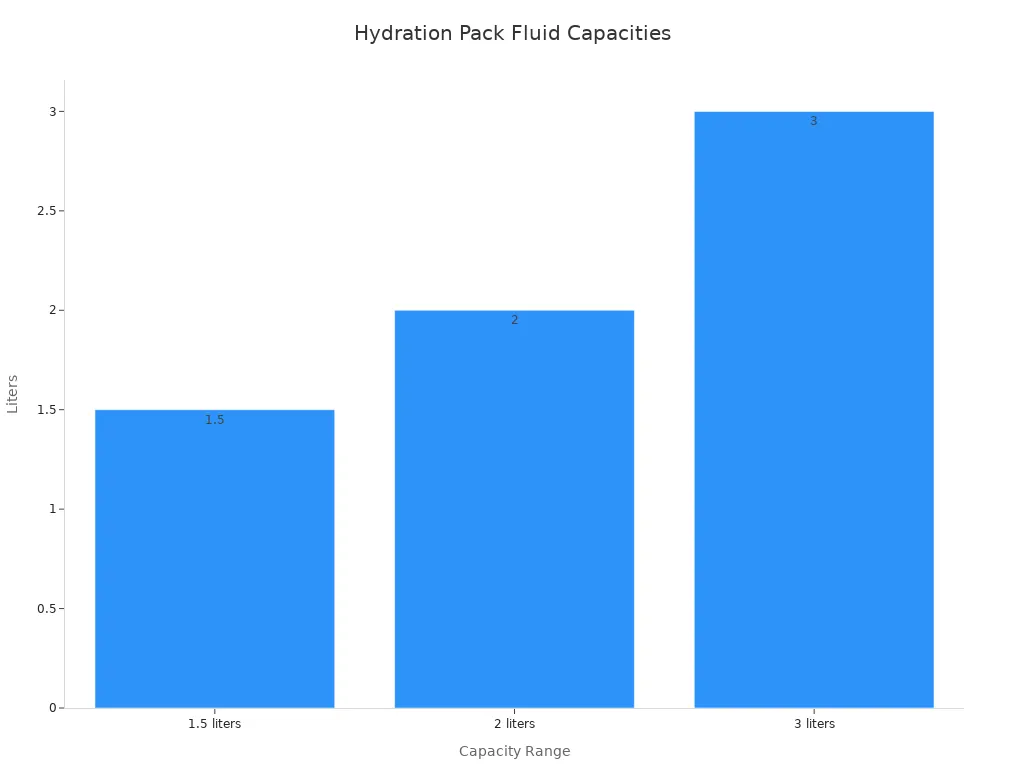
Tip: Don’t forget to check the gear space. You might need room for snacks, a jacket, or your phone.
Maintenance
Taking care of your hydration pack keeps your water safe and your gear working well. If you clean your pack often, you stop bacteria and mold from growing. You also keep your water tasting fresh. A clean pack lasts longer and works better.
Rinse the bladder after every use.
Use only water in the bladder to avoid bacteria.
Dry the bladder completely. Hang it upside down or use a drying rack.
Store the pack open so air can flow inside.
Clean more often if you use sports drinks or flavored water.
Try freezing the bladder to stop mold from growing.
Always let your pack dry before you put it away.
Keep airflow going during storage.
Regular cleaning means your pack stays safe and ready for your next adventure.
Note: A well-maintained hydration pack gives you fresh water and peace of mind every time you head outdoors.
Tactical Packs
Size
Choosing the right size for your tactical pack makes a big difference in your outdoor experience. You want a pack that fits your adventure, whether you’re heading out for a quick hike or planning a multi-day trip. Packs come in different sizes, and each works best for certain activities.
Size (L) |
Ideal Use |
Backpack Example |
Capacity |
|---|---|---|---|
20–30L |
Day hikes, short trips |
Maxpedition Falcon II |
20–30L |
40–60L |
Multi-day hiking, camping |
5.11 Tactical Rush 72 |
40–60L |
60–100L |
Heavy-duty, military, survival |
Mystery Ranch 3-Day Assault |
60–100L |
If you’re just going out for the day, a 20–30L pack gives you enough space for water, snacks, and a jacket. For camping or longer hikes, you’ll need a 40–60L pack to carry extra clothes, food, and gear. If you’re preparing for survival or military-style adventures, a 60–100L pack handles heavy loads and keeps your gear organized.
Tip: Try on different pack sizes before you buy. You’ll find the one that feels right for your body and your plans.
Material
The material of your tactical pack decides how tough and weatherproof it is. You want a pack that stands up to rough trails, rain, and sun. Most tactical packs use nylon or polyester blends. These fabrics resist tearing. Some packs add PVC coatings for extra water resistance and heavy-duty zippers to keep your gear dry.
Material |
Durability Impact |
Weather Resistance Impact |
|---|---|---|
Nylon Fabrics |
High strength, tear resistance, abrasion resistance |
Lightweight, good for long use |
Polyester Fabrics |
Good durability, mold and moisture resistance |
Excellent water resistance, great for damp areas |
PVC Coating |
Boosts abrasion resistance |
Increases water resistance, good for harsh weather |
Heavy-duty Zippers |
Lasts under stress |
Waterproof, adds to weather protection |
Nylon Fabrics: Strong and hard to tear.
Polyester Fabrics: Keeps out water and mold.
PVC Coating: Makes your pack tougher and more waterproof.
Heavy-duty Zippers: Stay strong and keep water out.
You can trust these materials to keep your gear safe, even when the weather turns bad or the trail gets rough.
Comfort
Comfort matters when you carry your pack for hours. Tactical packs use smart designs to help you feel good all day. You’ll notice padded straps, adjustable belts, and special frames that spread the weight across your hips and shoulders. This keeps your back from hurting and helps you move easily.
Feature |
Benefit |
|---|---|
Proper Weight Distribution |
Moves load to hips, less strain on back and shoulders |
Personalized Fit Adjustments |
Lets you adjust for your body, more comfort on long trips |
Strategic Pressure Distribution |
Spreads weight, stops pain points |
Movement Stability |
Keeps pack steady, helps you balance on tough trails |
You can wear a tactical pack for 8–12 hours without feeling tired.
Packs with good weight distribution help you walk farther and climb easier.
Adjustable straps let you find the perfect fit for your body.
Note: Always adjust your pack before you start your trip. A good fit means less pain and more fun.
Versatility
Tactical packs work for many outdoor activities. You can use them for hiking, camping, military training, or even rescue missions. Most packs have special pockets for hydration bladders, so you can drink water without stopping. Tube routing lets you sip water while you walk. MOLLE compatibility means you can attach extra gear, like first aid kits or tools.
Feature |
Description |
|---|---|
Dedicated Bladder Pockets |
Holds hydration bladders for easy access |
Tube Routing |
Lets you drink without taking off your pack |
MOLLE Compatibility |
Attach extra gear for different activities |
Police, first responders, soldiers, athletes, and adventurers all use tactical packs.
You can switch between hiking, camping, and training without changing packs.
Packs with hydration systems help you drink more often and stay energized.
You get instant access to water during tough activities.
You remember to hydrate more often.
You don’t need to stop for water breaks.
The Impermeable Tactical Backpack, for example, has a special pocket for a 3L hydration bladder. You can carry water, gear, and tools all in one pack. This makes your outdoor adventures smoother and safer.
Tip: Look for packs with MOLLE webbing and hydration pockets. You’ll be ready for anything, from a quick hike to a full weekend in the wild.
Buying Guide
Where to Buy
You have many options when it comes to purchasing a hydration pack or tactical bag. Many trusted online shops make shopping easy. You can visit panqistore.com for a wide selection. panqistore.com also offers hydration solutions for hiking, camping and other outdoor sports. If you want to get hydration packs or tactical packs at a cost-effective price. You can find customer service at panqistore.com to get samples before you buy.
SSource: panqistore.com: various tactical hydration packs; hydration packs for outdoor activities.
Tips If you're not sure which backpack is right for your needs, ask customer service for advice.
Budget
You should set a budget before you start shopping. High-quality tactical hydration packs usually cost between $87 and $178. Trusted brands like CamelBak and Condor offer durable options. Try not to pick the cheapest pack just to save money. Sometimes, low prices mean poor quality. You want a pack that lasts through many adventures.
Price range: $87–$178 for tactical hydration packs.
Note: Ignoring material quality or choosing price over durability can lead to disappointment.
Reviews
Reading reviews helps you make smart choices. Look for feedback from people who use their packs for outdoor sports. Reviews often mention comfort, durability, and ease of use. You can spot common problems or find out which packs work best for your favorite activities. Avoid packs with lots of complaints about zippers, straps, or leaks.
Check for comfort and fit.
Look for comments on durability.
Watch out for repeated issues.
Outdoor sports help you stay healthy, happy, and connected. The right hydration and tactical packs keep you safe and comfortable on every adventure. When you pick your gear, think about these tips:
Match your hydration system to your activity and the weather.
Try salt capsules to keep your electrolytes balanced.
Choose bottles if you want to refill and check your water easily.
You can boost your outdoor experience by making smart choices. Get outside, stay prepared, and enjoy every moment!
FAQ
How do you clean a hydration pack bladder?
You should rinse the bladder with warm water after each use. Use a cleaning brush for tough spots. Let it dry completely before storing. If you use sports drinks, clean it more often to prevent mold.
Can you use a tactical pack for school or travel?
Yes! Tactical packs work great for school or travel. You get lots of pockets for books, laptops, or clothes. The strong material keeps your stuff safe. Many people use them for daily life, not just outdoor sports.
What size hydration pack do you need for a day hike?
For a day hike, a 1.5 to 2-liter hydration pack usually works best. This size gives you enough water for several hours. You also get space for snacks and small gear.
Are hydration packs safe for kids?
Hydration packs are safe for kids if you pick the right size. Look for packs made for children. These fit smaller bodies and are easy to use. Always check that your child can carry the pack comfortably.
How do you stop water from tasting bad in your hydration pack?
Tip: Rinse your bladder with baking soda and water. Let it sit for 30 minutes, then rinse again. This helps remove plastic taste. Store the bladder dry and open to keep it fresh.
